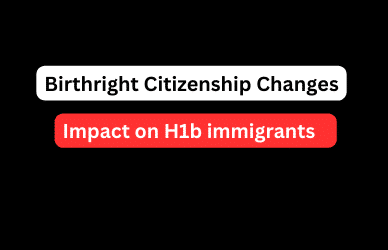If you’re currently in the U.S. on an H-1B visa and considering a transition back to student life, you’re not alone. Many professionals choose to change their visa status from H1B (a work visa) to F1 (a student visa) to pursue further education or shift their career paths.
The F-1 visa is designed for international students attending U.S. academic institutions. In this guide, we’ll walk you through the steps to change your visa status from H-1B to F-1, covering important details like the application process, costs, and timelines.
Changing from H1B to F1 Process
Switching from an H-1B work visa to an F-1 student visa involves several steps. Below is a general outline of the process:1. Get Admission to a SEVP-Approved School
Before you can apply for an F-1 visa, you must first secure admission to a U.S. institution authorized to accept international students (SEVP-approved). This means you’ll need to apply to and get accepted by the school of your choice.2. Obtain Form I-20 from Your School
Once admitted, the school will issue a Form I-20 (Certificate of Eligibility for Nonimmigrant Student Status). This document is essential for your F-1 visa application and proves that you have been accepted to study in the U.S.3. Apply for a Change of Status
To change your visa status from H-1B to F-1, you’ll need to file Form I-539 (Application to Extend/Change Nonimmigrant Status) with the U.S. Citizenship and Immigration Services (USCIS). This form allows you to request a change to your visa classification.4. Provide Supporting Documents
Along with your Form I-539, you’ll need to submit the following: – Your Form I-20 from the U.S. school – Evidence of financial support to cover tuition and living expenses – Copies of your passport, H-1B visa, and I-94 record – Proof of your intent to return to your home country after completing your studiesCost of Changing from H1B to F1
The main costs associated with changing your status include the following: – Form I-539 Filing Fee:** $455 – Biometrics Fee (if required):** $85 Additional fees may apply, depending on the specific requirements of your case. The school may also charge a SEVIS (Student and Exchange Visitor Information System) fee, typically $350.Timeline for Processing the Change of Status
Processing times for the change from H-1B to F-1 status can vary. Generally, the USCIS may take several months to process Form I-539. Be sure to check the processing times for the service center handling your case. You can expedite the process by opting for premium processing if available, although this is not always an option for change of status applications.Maintaining Status During the Transition
One critical consideration during the transition from H-1B to F-1 is maintaining lawful status in the U.S. If your H-1B employment ends before the change of status is approved, you may be required to leave the U.S. and re-enter with an F-1 visa from a U.S. embassy or consulate abroad.Benefits of Changing from H1B to F1
– Education Opportunities: Pursuing higher education can open new career pathways or allow you to specialize in a field of interest. – Work Options: While on F-1 status, you can explore on-campus employment, internships through Curricular Practical Training (CPT), or Optional Practical Training (OPT) during or after your studies. – Extended U.S. Stay: Changing to F-1 status allows you to remain in the U.S. legally for the duration of your studies, potentially followed by an additional year or more on OPT.Frequently Asked Questions about Changing from H1B to F1
Here are some common questions that applicants face when transitioning from H-1B to F-1, summarized from the official USCIS guidelines:Q: What if My Current Status Doesn’t Allow Me to Enroll in Classes? A If your current nonimmigrant status (like H-1B) doesn’t allow you to enroll in classes, you must wait for USCIS approval of your change to F-1 status before beginning any studies. If your application hasn’t been processed 15 days before the program’s start date, contact the school’s designated school official (DSO). If your status isn’t changed by the program start date, you may need to defer your attendance to the next term. Q: What if My Change of Status Application is Still Pending Within 30 Days of My F-1 Program Start Date? A: Due to processing delays, you may need to work with your DSO to defer your F-1 start date to the next academic term if your change of status (COS) application remains pending. If approved, the change of status becomes effective immediately upon approval, even if your program start date is still in the future. Q: What if My Change of Status Application is Approved More than 30 Days Before My F-1 Program Start Date? A: If USCIS approves your F-1 application more than 30 days before the start date on your Form I-20, you must not violate your F-1 status by working or engaging in other unauthorized activities before your program begins. Early employment, even on-campus, could result in a violation of your F-1 status.By understanding these key guidelines, you can ensure a smoother transition from H-1B to F-1 status while maintaining your lawful presence in the U.S. Always work closely with your DSO to navigate timelines and requirements effectively. Switching from H-1B to F-1 is a multi-step process, but for many, the opportunity to pursue academic goals and broaden career options makes the journey worth it. Ready to take the next step? Visit our website h1bvisahub where you can get access to expert legal advice and tons of resources on F1 and H1b visas.






